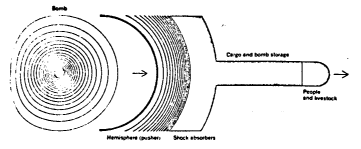
Xenology: An Introduction to the Scientific Study of Extraterrestrial Life, Intelligence, and Civilization
First Edition
© 1975-1979, 2008 Robert A. Freitas Jr. All Rights Reserved.
Robert A. Freitas Jr., Xenology: An Introduction to the Scientific Study of Extraterrestrial Life, Intelligence, and Civilization, First Edition, Xenology Research Institute, Sacramento, CA, 1979; http://www.xenology.info/Xeno.htm
17.3.1 Nuclear Pulse Propulsion
In the 19th century Hermann Ganswindt proposed the use of a series of gun powder charges behind a vessel to propel it into space.2762 The concept of nuclear pulse propulsion, the modern extension of this basic idea, was developed under USAF contract at Gulf General Atomic during the years 1958-1965.
Dubbed "Project Orion" by the scientists who worked on it, the system operates by tossing out a nuclear bomb, exploding it astern of the ship, and absorbing part of the momentum of the resulting debris. The rocket thus consists of at least five distinct parts: An hemispheric ablation shield or "pusher plate," an enormous shock absorber, a mechanism for ejecting the bombs, the bomb magazine, and finally the payload at the front end. Small test models using steel pusher plates and TNT charges were successfully flown during the experimental phase of Project Orion, but the work was shelved after the Nuclear Test Ban Treaty entered into force late in 1963. (The Treaty prohibits the explosion of nuclear devices in the atmosphere or in space.)
Freeman J. Dyson of the Institute for Advanced Study at Princeton, New Jersey, who worked on Project Orion, described a prototype model of a space vehicle utilizing the principle of nuclear pulse propulsion.476 His "Ablation Space Ship" has a total mass of 400,000 metric tons, consisting of 300,000 tons of one-megaton H-bombs (weighing 1000 kg each), 50,000 tons of structure and payload, and 50,000 tons of ablation shield. The pusher plate construction is such that about 30 meters/second forward velocity are imparted to the vessel with each explosion. A smooth 1-gee acceleration is maintained by the detonation of one bomb every three seconds, which requires a shock absorber stroke length of about 75 meters (Figure 17.1).
Figure 17.1 Project Orion (from Dyson478)
Dyson’s nuclear pulse vehicle exhausts its bomb supply in ten days, having reached a final velocity of 10,000 km/sec (about 3.3%c). The flight time from Earth to Proxima Centauri would then be 130 years for a simple flyby mission. For an encounter-capture mission the payload must be decelerated at the target, which more than doubles the time of flight for a vehicle of this size.
Figure 17.2 Nuclear Pulse Vehicle (from Forward718,2812)
More efficient variants of the nuclear pulse technique have been suggested in recent times (Figure 17.2), particularly the idea of igniting tiny deuterium pellets instead of huge bombs behind the ship. Ignition would be achieved using pulsed laser beam fusion2751,2752 or heavy ion or electron beam fusion.2764 This latter technique has been selected for use in the Daedalus starprobe, an interstellar vehicle designed as part of a feasibility study sponsored by the British Interplanetary Society during 1975-1977.2953 In the Daedalus system, a 54,000-ton craft is propelled up to 12%c using a stream of frozen deuterium/helium-3 pellets which are zapped by a megavolt electron gun 250 times a second. The designers claim that the probe should be able to reach Proxima Centauri in 35 years with a 500-ton payload.2761
Last updated on 6 December 2008